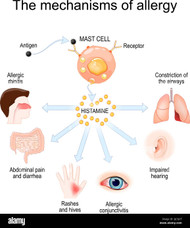Mast Cell Activation vs. Histamine Intolerance: What They Are, How They Differ, and How They Affect Your Skin
Posted by Brazen Bee Beauty on Apr 18th 2025
As a skincare herbalist, I see many of my clients struggling with mysterious skin issues that don't always respond to the usual treatments. Often, the root cause lies deeper, involving imbalances in the immune system and the body's histamine pathways. Two common but often misunderstood culprits are Mast Cell Activation Syndrome (MCAS) and Histamine Intolerance (HIT). Today, we'll dive into what they are, their differences, similarities, and how they can show up on your skin.
What is Mast Cell Activation Syndrome (MCAS)?
Mast cells are a type of immune cell found throughout the body, especially near blood vessels and the surface of the skin. They are "first responders," releasing substances like histamine, cytokines, and prostaglandins during injury or allergic reactions to protect us.
In MCAS, these mast cells become overly reactive. They release their chemical contents inappropriately and excessively, even without a true threat. This overactivation can lead to widespread, chronic inflammation and a wide variety of symptoms, including those affecting the skin.
What is Histamine Intolerance (HIT)?
Histamine is a naturally occurring chemical involved in digestion, immune response, and nervous system communication. Normally, the body breaks down histamine using enzymes like diamine oxidase (DAO) and histamine N-methyltransferase (HNMT).
Often people who have MTHFR deficiency stuggle with histamine intolerance. MTHFR deficiency is found with a simple genetic test involving a cheeck swab ordered by your provider. It is easily treated with supplementation. If you would like a recommendation for a good provider who accepts insurance: 
Quick Provider Bio:
Pediatric & Family Psychiatry takes a functional psychiatry approach to include, functional nutritional therapy, to your mental health: by first ruling out organic/medical causes for mental health symptom presentation through specialized testing (specific detailed labs, genetic/PgX testing, brain scanning), and naturally supporting your body. YOU are the MOST important person on your treatment team, and the driver of your treatment.
In histamine intolerance, there is either too much histamine being introduced or not enough enzyme activity to break it down properly. The result is an accumulation of histamine in the body, leading to allergy-like symptoms — without a true allergy.
Similarities Between MCAS and HIT:
-
Both involve histamine and can cause overlapping symptoms.
-
Both can lead to chronic skin problems like rashes, hives, and itching.
-
Both are often triggered by foods, stress, environmental exposures, and infections.
-
Both require careful attention to diet and lifestyle to manage symptoms.
Differences Between MCAS and HIT:
-
Source of the Problem: MCAS is about immune cells (mast cells) being hyperactive; HIT is about an inability to clear histamine properly.
-
Complexity: MCAS often affects multiple chemical mediators, not just histamine, whereas HIT is specifically about histamine accumulation.
-
Diagnostic Approach: MCAS often needs immune markers or mast cell mediator tests; HIT is usually suspected based on symptoms and response to low-histamine diets.

How Mast Cell Activation Can Present in Skin:
-
Chronic, unexplained hives (urticaria)
-
Dermatographism (skin writing - raised red lines when skin is scratched)
-
Redness, flushing, or blotchy rashes
-
Itchy or burning sensations without clear cause
-
Swelling (angioedema), especially around the eyes or mouth
How Histamine Intolerance Can Present in Skin:
-
Redness and flushing after eating
-
Mild hives after certain meals (especially aged foods)
-
Itchy skin without a visible rash
-
Puffiness or "heat" in the face and hands
Challenges with Skincare for MCAS and HIT:
Skincare for those with mast cell activation and histamine intolerance can be extremely challenging. Many conventional skincare products contain ingredients like fragrances, preservatives, and even botanical extracts that can trigger mast cell degranulation or histamine release. Even "natural" products can be problematic if they contain high-histamine botanicals or hidden allergens.
Individuals with MCAS and HIT often have highly reactive skin that can suddenly flare with redness, burning, swelling, or itching, even after years of using a product without issue. Finding products that are fragrance-free, preservative-minimal, and formulated with very simple, calming ingredients is crucial.
Patch testing new products on a small area of skin and waiting 24-48 hours is highly recommended. Look for formulas with:
-
Minimal ingredients
-
No essential oils (for very sensitive individuals)
-
No alcohol-based extracts
-
Cooling and barrier-repairing ingredients like aloe vera (low histamine) and calendula
How Mast Cell Activation Can Present in Facial Skin:
-
Persistent redness, especially on the cheeks, nose, and forehead
-
Swelling of the lips, eyelids, or face
-
Flare-ups of burning, itching, and stinging sensations
-
Patches of hives or rash-like irritation
How Histamine Intolerance Can Present in Facial Skin:
-
Flushing after eating or drinking certain foods (wine, cheese, fermented items)
-
Puffiness under the eyes or around the cheeks
-
Occasional small red bumps or itchy patches, especially after meals
-
Heat and discomfort in the face without an obvious rash
Final Thoughts:
If you're struggling with stubborn skin issues that don't seem to have an obvious cause, it's worth considering histamine and mast cell involvement. From an herbalist perspective, addressing these concerns naturally may involve:
-
Supporting liver health to aid in histamine breakdown
-
Using mast cell stabilizing herbs like quercetin, nettle, and holy basil
-
Avoiding high-histamine foods and fermented products temporarily
-
Focusing on gut healing to regulate immune responses
Understanding the delicate dance between your immune system and histamine pathways can be the missing link to achieving truly radiant, healthy skin.


